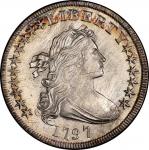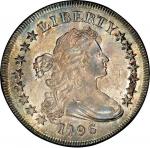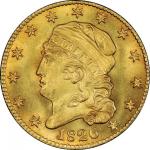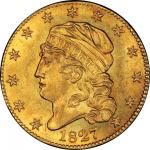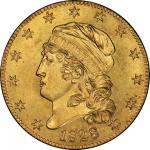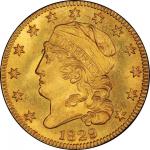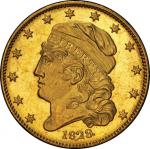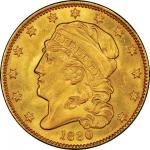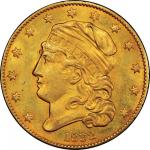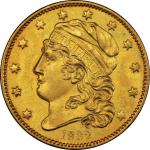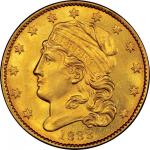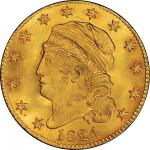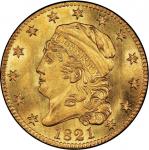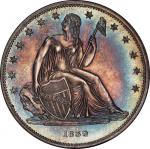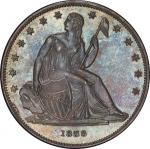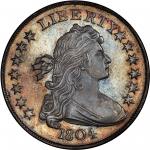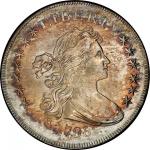From my own observation, I believe this variety to be of the greatest rarity.” — John H. Clapp, The Numismatist, December 1912</em>A long cherished rarity, this variety was missing from the nearly complete Harry W. Bass, Jr. Collection. The D. Brent Pogue example, earlier one of the most prized half eagles in the Eliasberg Collection, is the finer of just two examples known of this legendary overdate. Unlike the other variety of 1825, this obverse shows an extremely bold 4 beneath the final date digit. While the overdate on the BD-1 variety is in nearly the same position, this overdate was cavalierly punched, with only minimal effort to hide the modification. With fame and rarity that has stood for a century, this remains one of the most important of all half eagles of this type.Long considered a Proof, this example shows substantial and bright reflectivity on both obverse and reverse. The surfaces are rich yellow, luscious with originality and showing a few peeks of coppery color on the reverse. While some cartwheel is visible, the dominant luster is of a reflective nature, just as bold on the reverse as on the obverse. The strike is excellent if not complete, with some softness at Liberty’s ear curl. An area of crumbled ill-formed denticles in the northwest quadrant of the obverse is also seen on the other known survivor of this obverse. A scattering of light marks and faint lines are seen in the fields, including a nick just above star 11 and a thin scratch from the arrow butt to the lower right pair of olive leaves. Two circular depressions above the eagle’s head are natural, struck-throughs of the sort often seen on gold coins of this era, and a minor flaw right of the E of STATES was likewise made at the Mint. A series of fine obverse die cracks may have helped guarantee the rarity of this obverse. Beginning in the field below the tip of the bust, one crack joins stars 1 and 2, while another connects stars 3, 4, 5, and 6, visibly changing the plane of the field as it passes between stars 3 and 4. A seemingly different crack joins stars 6 through 9 at the inner points that parallel the rims, while another crack joins stars 9 and 10 at the outer points that parallel the rims. Star 11 stands alone, with a light crack toward star 10 that does not reach it. The overdate is bold, with the 5 punched extremely deeply over the 4. A lump of frost on the upright of the 4 may be a remnant of an effacing operation. Two subtle raised artifacts right of these digits are related, though they are neither cracks nor lapping lines. The reverse is in the same state as seen on 1825 BD-1, with the prominent frost fields under ITE and right of the denomination. The blank areas under the shield, and much of the inner shield’s periphery, are likewise filled with frost, as seen on the other 1825 variety. The die rotation is perfect coin turn.Between 1912, when the discovery of this variety was first promulgated in the pages of <em>The Numismatist,</em> and 1978, when a second example was discovered tacked to the wall of a bank on Michigan’s Upper Peninsula, this was the only example of this variety known. Researcher David Stone revealed that the 1825/4 variety was both identified and recognized as a rarity as early as October 1864, when W. Elliot Woodward described a coin that sounds rather like this one in his Fifth Semi-Annual Sale: “1825 over 1824, Proof impression; exceedingly rare, the first offered at public sale.” The coin sold for an enormous sum, $41, the highest price realized of any gold coin in the sale. A named copy of the catalog in the American Numismatic Society, made available by the Newman Numismatic Portal, reveals the buyer was Ely, but which one? Both Foster Ely, whose collection was sold by John Walter Scott in November 1888, and Heman Ely, whose coins were dispersed in Woodward’s sale of January 1884, collected half eagles at an advanced level. While Foster Ely’s sale did not include an 1825 $5 of any grade or variety, the Heman Ely sale included one as lot 837 that was described as “splendid Proof, excessively rare. Purchased by Mr. Cogan in my sale, June 29, 1864.” Despite the poor recollection of a date from 20 years earlier – his Fifth Semi-Annual Sale was in October, not June – the coin sold in January 1884 was the coin from Woodward’s Fifth Semi-Annual Sale. Ely bought other rare early half eagles in that sale, including a very rare 1795 Heraldic Eagle reverse, a 1797 16 Stars, an 1820, and an 1832. Each of them reappears in the January 1884 Heman Ely sale. The 1795 Heraldic Eagle reverse is noted as being from “McCoy Coll., No. 1941,” referring to Woodward’s May 1864 sale; it may have been a buyback at the time and found a buyer in the October 1864 sale. In the description for the 1832 half eagle in the Ely sale, Woodward correctly notes that it “cost Mr. Ely $34,” the price it realized at the October 1864 sale. The introduction to the 1884 Ely sale makes note of Ely’s purchases in 1864, and even mentions Ed Cogan as his favorite dealer at that time. Presumably Cogan represented Ely in the sales room.It is safe to acknowledge the near-certainty that the “exceedingly rare” “Proof impression” of the 1825/4 half eagle that sold to Ely in 1864 was the same coin found in Heman Ely’s collection in 1884, where it was described as “splendid Proof, excessively rare,” but the leap to connecting that coin to the one presently offered is more speculative. If the lofty 1864 price realized is evidence of the Ely coin’s choice condition, it seems sensible to assume that this coin, not the lower quality Kaufman 1825/4 half eagle, has a better chance of being the Ely coin. Logically, if this coin was in the Ely Collection from 1864 to 1884, it could not have been sold in the Mendes Cohen sale of 1875, as has long been assumed. The connection between this coin and the Cohen sale seems to have been first made by Walter Breen; the Cohen sale was included in the provenance of this coin when Breen’s 1966 half eagle monograph was published. Until David Stone’s 2011 article in <em>The Numismatist,</em> the initial October 1864 appearance of the 1825/4 half eagle seems to have been forgotten by everyone, including Breen. When Breen wrote in 1966, this specimen was the only example known; connecting the only known specimen to the only 19th century auction appearance known to him was natural. With more research resources available today, and the knowledge of a second known example, the odds that this is the Mendes Cohen coin diminishes, yielding to a potentially more impressive and antique provenance.The buyer of the 1825/4 half eagle in the Heman Ely sale was W. Elliot Woodward himself, identified with the codename “Francher” in John Haseltine’s salesroom copy. “Francher” also bought the easily traced 1828 half eagle with GW graffiti on the obverse. That coin reappeared in Woodward’s Kingdoms of the World sale, where his own collections were sold. Along with the graffitied 1828 half eagle sold in lot 1156, the Heman Ely 1825/4 was presented in lot 1153, described as “fine proof, extremely rare.” Pending the discovery of a named copy of the Kingdoms of the World sale, there the trail runs cold on the discovery coin of the 1825/4 half eagle. Such documentation may prove that that example is the Earle-Clapp-Eliasberg-Pogue coin, or it could help refute it.The presently offered specimen was unquestionably offered in the 1912 sale of the George H. Earle, Jr. Collection, which Henry Chapman soberly called “the finest collection ever offered in this country.” Photographically illustrated on Plate XXVIII, this coin was purchased by John H. Clapp, who added it to his magnificent holdings of United States gold coins. At the time, Clapp was one of the country’s greatest scholars on the topic of early gold coins and varieties, ranking with Edgar Adams and, of a slightly later generation, Waldo Newcomer. Despite his expertise, Clapp was apparently unaware than the 1825/4 had ever been described before. He excitedly announced his discovery in a letter to the editor of <em>The Numismatist</em>, dated November 5, 1912.There are two distinct varieties of the 1825 half eagle. The ordinary variety is the one listed in all catalogues as ‘over 21.’ This I believe is a mistake, as a careful examination of specimens will show little evidence of it being an overdate, but on the contrary will show that it was simply a slip in the die making a line somewhat resembling a 1. In the Earle sale, I purchased, however, another distinct variety, which is the only specimen of the kind I know of and I have searched all old plated catalogs and have not found another one. It might well be described as over 1824, as the four is very plain under the five and does not in any way look like a 1 nor could it be mistaken for one. From my own observation, I believe this variety to be of the greatest rarity, though of course there may be others.The story of this coin was static for 65 years thereafter. The 1825/4 became widely acknowledged as one of the greatest rarities in the United States series, celebrated as rarer than the 1815 or 1822. Edgar Adams wrote in his notebook on half eagle varieties that he had never seen one “after examination of a considerable number of the date.” Wayte Raymond’s <em>Standard Catalogue</em> published this overdate as “possibly unique.” Walter Breen stated in his 1966 monograph that only one was confirmed.In 1978, the outside world learned about a coin collection that had been known in Marquette, Michigan for decades. Mounted on a wall, Nathan M. Kaufman’s collection of gold had been on display since the 1920s at the First National Bank of Marquette. The star of the collection proved to be the second known 1825/4 half eagle. It was featured on the cover of RARCOA’s sale catalog of the collection and, as noted in the 1982 Eliasberg catalog, “sold to the Kagin Coin Company for $140,000. The new owners promptly announced that they would have paid much more.”That coin is today certified as AU-50 (NGC). It last sold in July 2008. There are no other examples rumored. None exist in any institutional collection. Neither Josiah K. Lilly nor Harry W. Bass, Jr. ever owned this variety. It was missing from Waldo Newcomer’s collection and E.H.R. Green’s amazing hoard of early half eagles. Since 1912, this coin has sold at auction only once. It is the finest known example, by a wide margin, of one of the foundational rarities among the early half eagle series. In this sale so full of highlight rarities, this coin falls behind few of them.PCGS# 8134.



